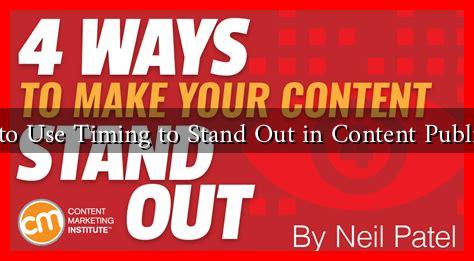-
Table of Contents
How to Use Timing to Stand Out in Content Publishing
In the fast-paced world of content publishing, timing can be the difference between a post that goes viral and one that gets lost in the noise. Understanding when to publish your content, how to leverage current events, and the importance of seasonal trends can significantly enhance your visibility and engagement. This article explores effective strategies for using timing to stand out in content publishing.
The Importance of Timing in Content Publishing
Timing is crucial in content publishing for several reasons:
- Audience Engagement: Posting at the right time can maximize audience engagement. Research shows that social media posts have higher interaction rates during specific hours.
- Relevance: Timely content is often more relevant, making it more likely to resonate with your audience.
- SEO Benefits: Search engines favor fresh content, so timing your posts can improve your search rankings.
Understanding Your Audience’s Behavior
To effectively use timing in your content strategy, you must first understand your audience’s behavior. Here are some steps to consider:
- Analyze Analytics: Use tools like Google Analytics to track when your audience is most active. Look for patterns in engagement metrics.
- Social Media Insights: Platforms like Facebook and Instagram provide insights into when your followers are online. Use this data to inform your posting schedule.
- Surveys and Feedback: Directly ask your audience when they prefer to consume content. This can provide valuable insights into their habits.
Leveraging Current Events and Trends
Another effective way to stand out is by aligning your content with current events and trends. Here’s how:
- Newsjacking: This involves creating content that relates to a current news story. For example, if a major event occurs, consider how your brand can relate to it. A classic example is Oreo’s tweet during the Super Bowl blackout in 2013: “You can still dunk in the dark.”
- Seasonal Content: Tailor your content to fit seasonal trends. For instance, publishing holiday-themed articles or guides can attract more traffic during peak seasons.
- Industry Trends: Stay updated on trends within your industry. Tools like Google Trends can help you identify what topics are gaining traction.
Optimal Timing for Different Platforms
Different platforms have varying peak times for engagement. Here’s a quick guide:
- Facebook: Best times are typically between 1 PM and 3 PM on weekdays.
- Twitter: Engagement peaks during lunch hours, around 12 PM to 1 PM.
- Instagram: Posts perform well on weekdays, especially on Wednesdays at 11 AM.
- LinkedIn: The best times to post are during business hours, particularly on Tuesdays, Wednesdays, and Thursdays.
Utilizing these optimal times can significantly increase your content’s visibility and engagement rates.
Case Studies: Brands That Got Timing Right
Several brands have successfully leveraged timing in their content strategies:
- BuzzFeed: Known for its timely quizzes and articles, BuzzFeed often capitalizes on trending topics, ensuring their content is relevant and engaging.
- Netflix: The streaming giant often releases content strategically around holidays or major events, maximizing viewer engagement.
- Wendy’s: The fast-food chain has mastered the art of real-time marketing, often tweeting witty responses that align with current events or trends.
Conclusion
In the competitive landscape of content publishing, timing is a powerful tool that can help you stand out. By understanding your audience’s behavior, leveraging current events, and optimizing your posting schedule for different platforms, you can significantly enhance your content’s reach and engagement. Remember, the key to successful content publishing lies not just in what you say, but when you say it. By implementing these strategies, you can ensure that your content not only reaches your audience but resonates with them as well.
For more insights on content marketing strategies, check out HubSpot’s Marketing Statistics.


